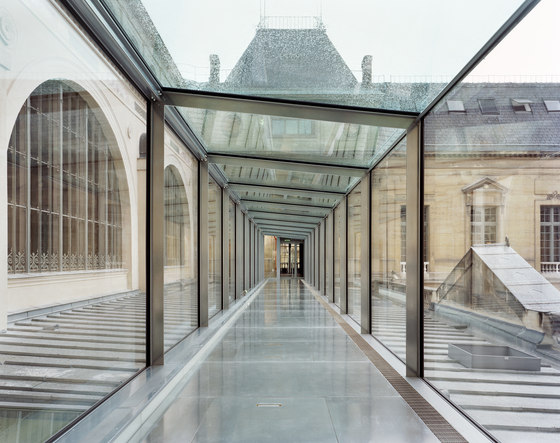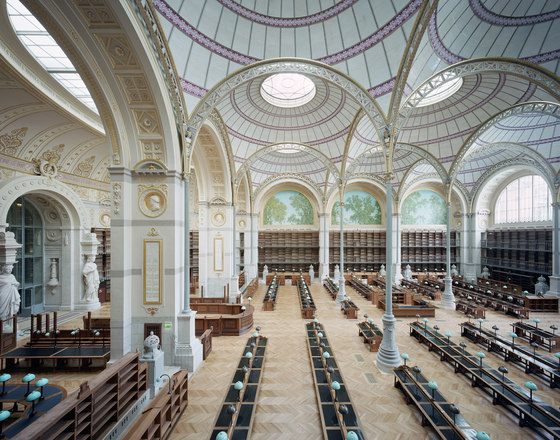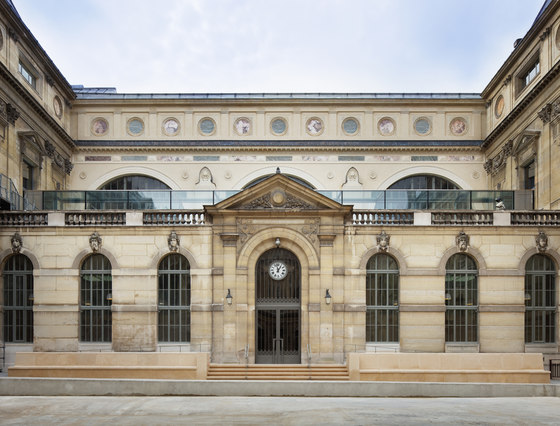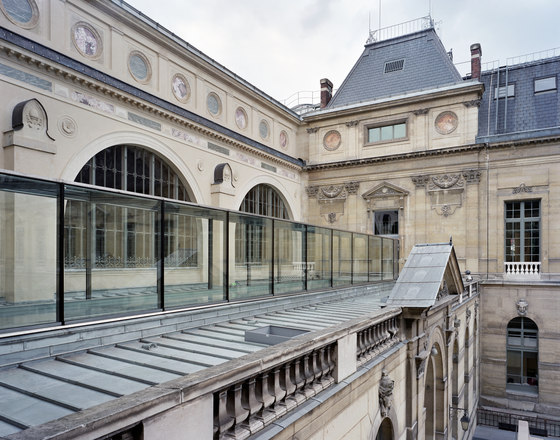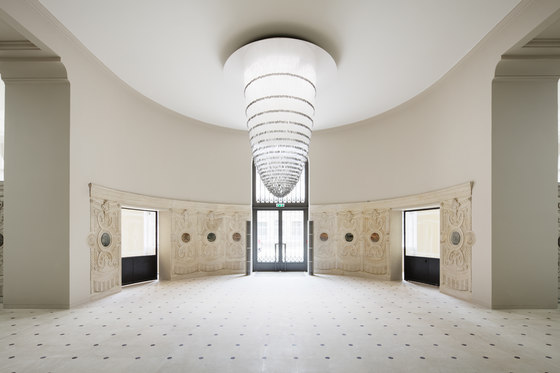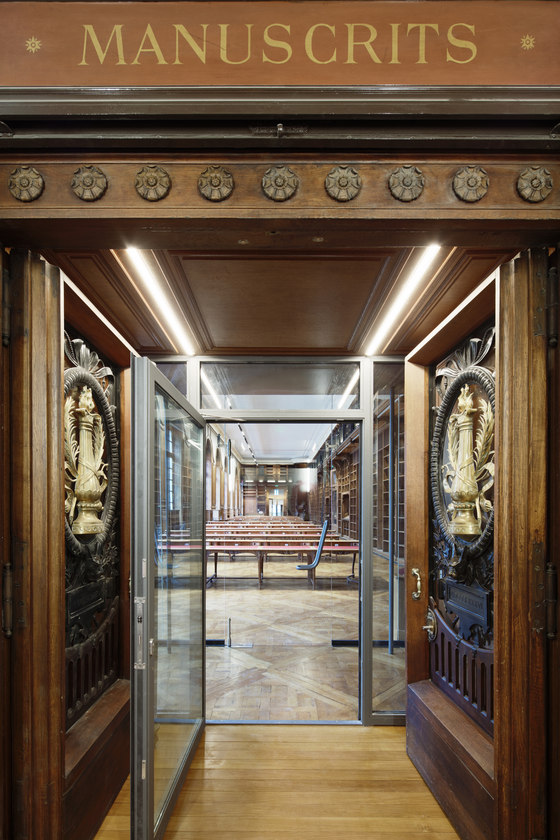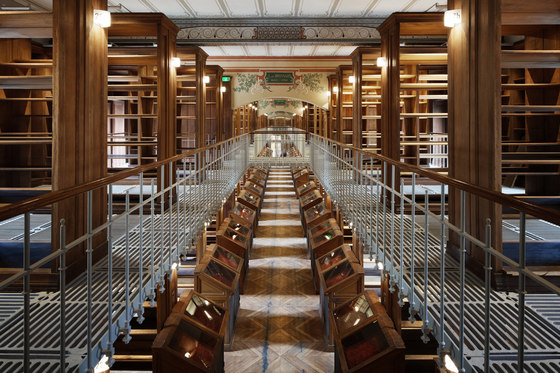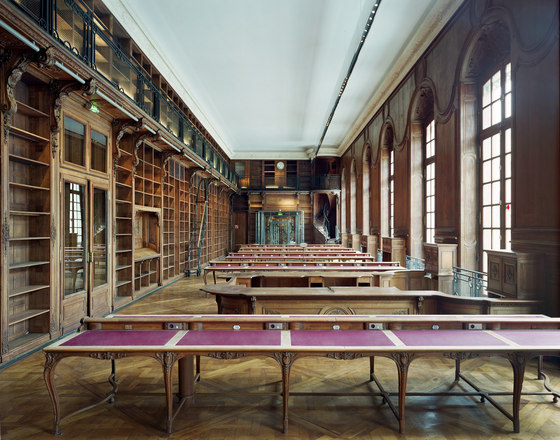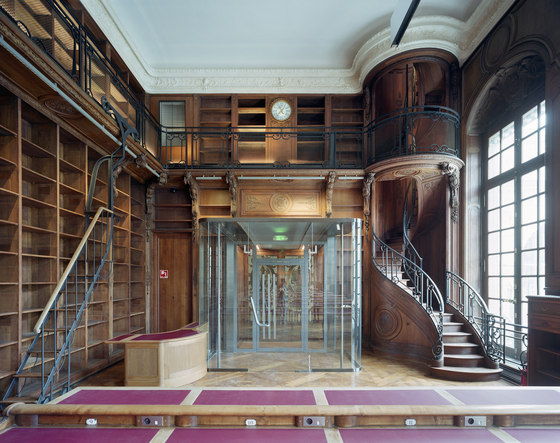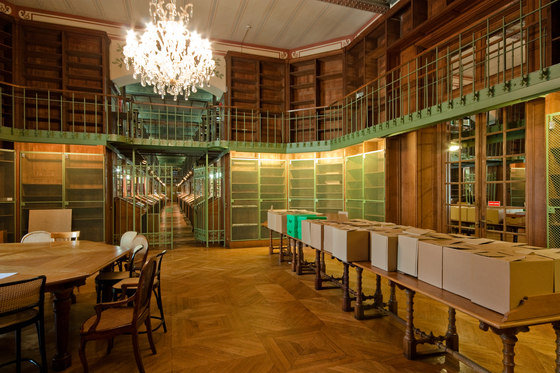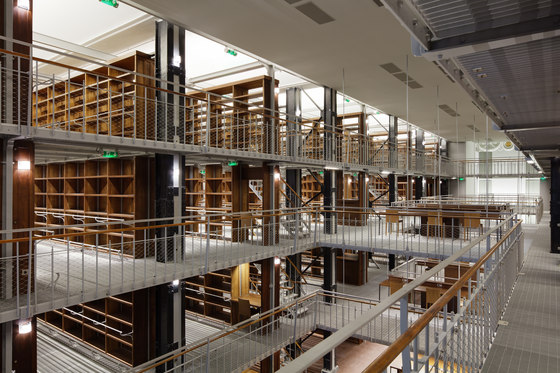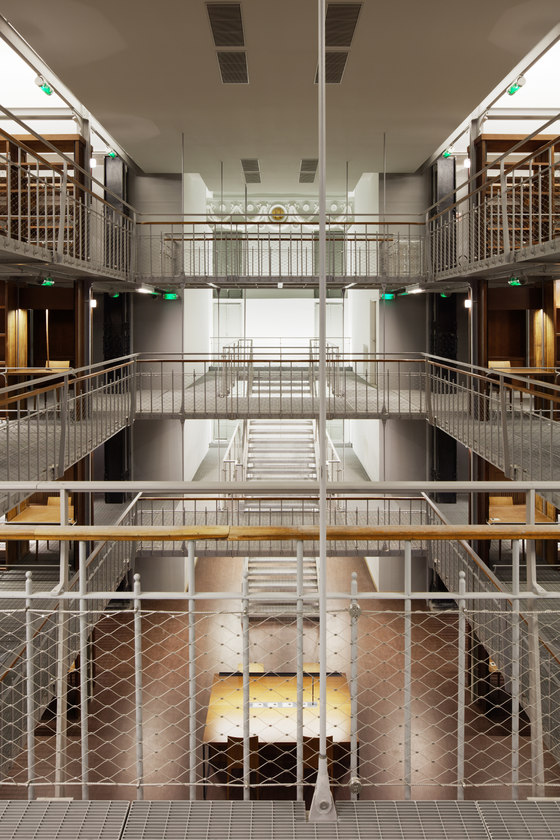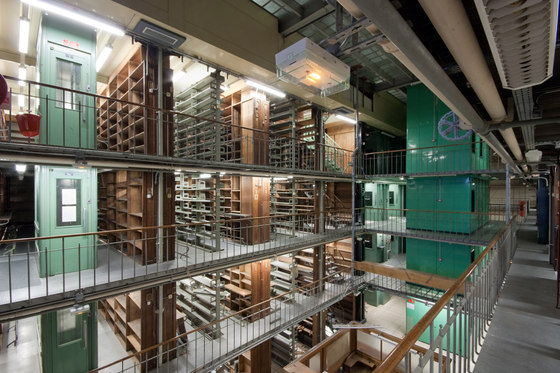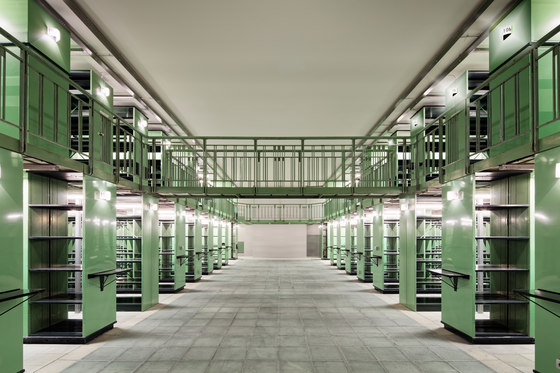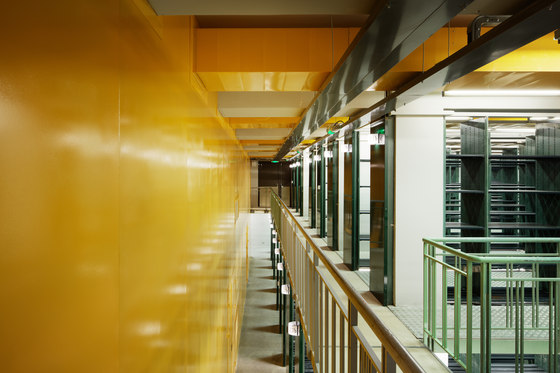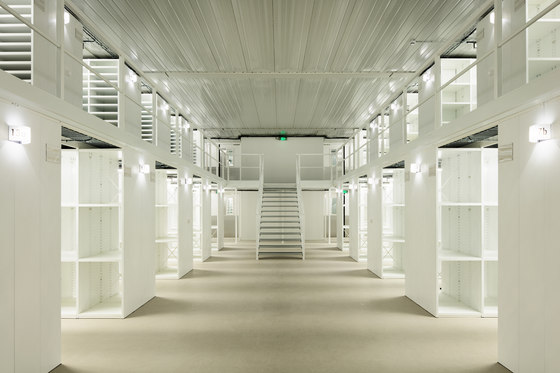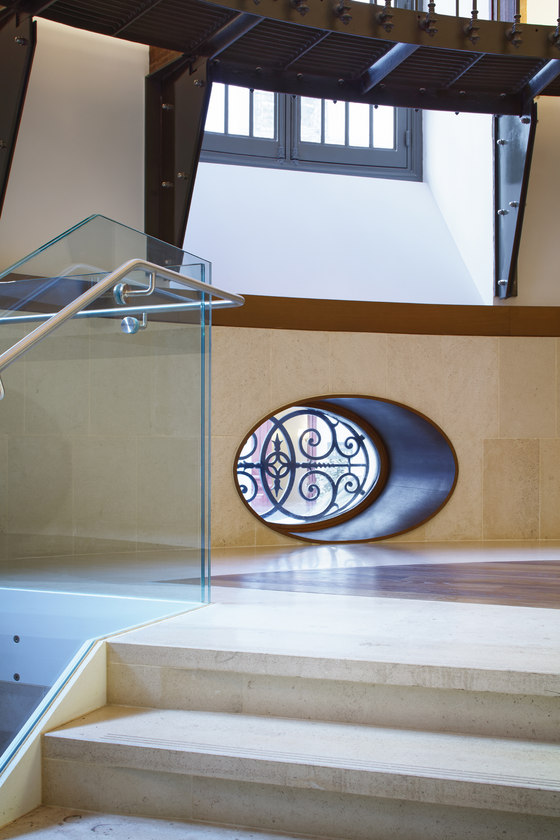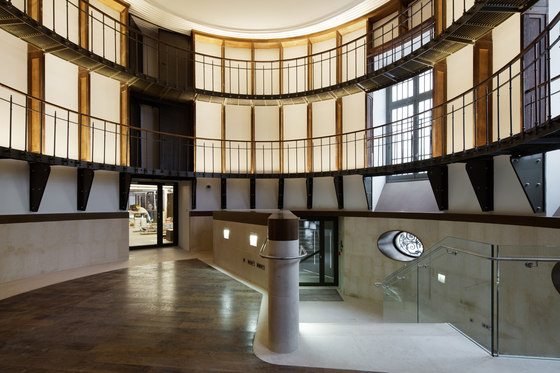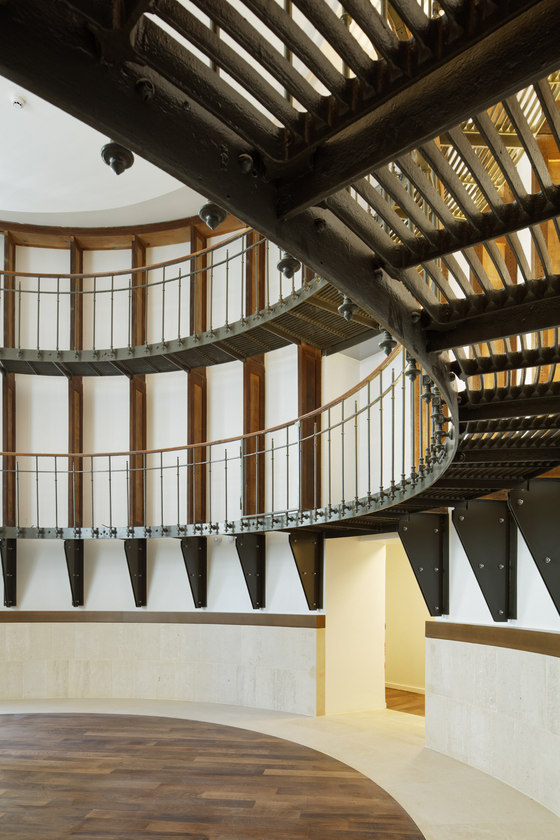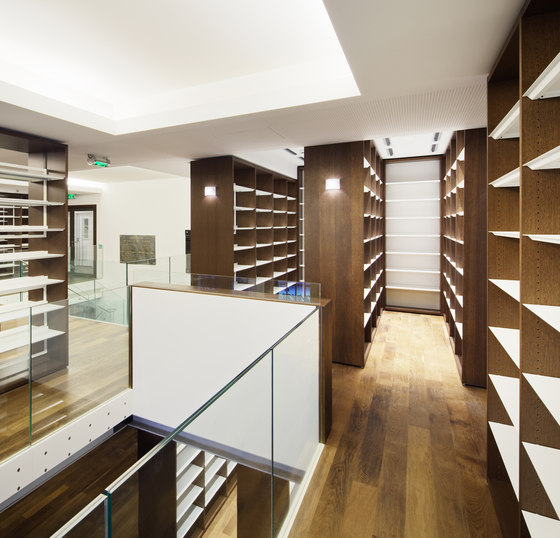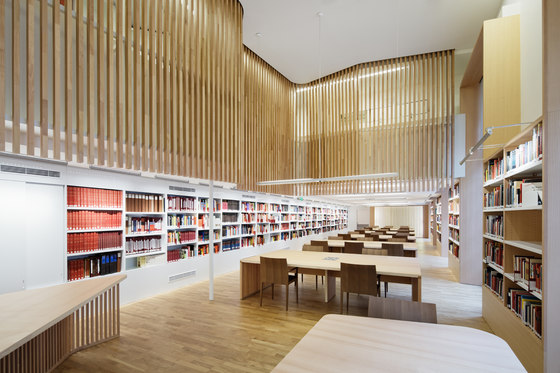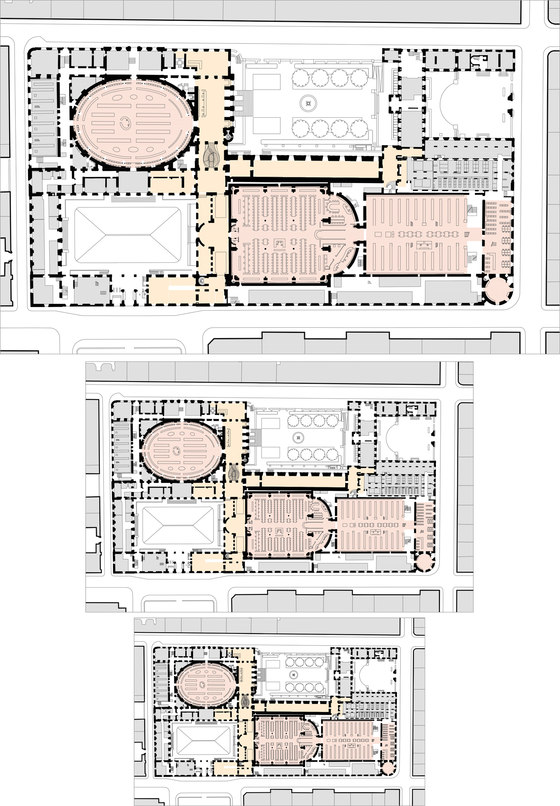The Richelieu Quadrangle, “parent institution” of the Bibliothèque Nationale de France, houses the prestigious collections and reading rooms of the Manuscripts Department, the Maps and Plans Department, the Coins, Medals and Antiques Department and the Performing Arts Department. Since 1993, the Quadrangle is also home to the Bibliothèque de l’Institut National d’Histoire de l’Art (INHA, the French national art history library) and, since the completion of the frst phase of renovations a few months ago, the Bibliothèque de l’École des Chartes will also take up residence here. Three prestigious institutions are thus to be gathered in this same “jewelry case,” forming in the heart of Paris a unique center of excellence of Art and History in the world.
In the early 2000s, observing this aging edifce led to the inevitable conclusion the site had become obsolete. This included its technical and security installations, the conditions under which the public was received, as well as working conditions and conditions for conservation of the collections. The building no longer fulflled the role for which it had been designed. A major overhaul had become urgently necessary. And this could no longer be carried out “bit by bit”, as had been done since the late 1950s – period during which Michel Roux-Spitz’s extensions were completed – but rather by means of a major campaign of works on the scale of the entire complex of buildings on the site.
The outcome of the negotiated deal included the general project management being entrusted to Bruno Gaudin’s architecture offce. The restoration of the Salle Labrouste, a structure listed in the ISMH (Inventaire Supplémentaire des Monuments Historiques), was entrusted to Jean François Lagneau ACMH (architect in chief of Monuments Historiques). Preliminary studies on
the entire Quadrangle began in 2007.
The works, which began in 2011, were divided into two phases to enable both the setting up of the particularly delicate construction site and, in parallel, to be able to keep the library partially open on the rue Vivienne side. Although the Quadrangle’s visibly distinct geometric forms are divided into ordered units (immense reading rooms, courtyards, garden, etc.) the gradual expansion of the complex since the 17th century was carried out through endless transformations, enlargements, demolitions, and densifcations. Behind the unifed and ordered envelope of the stone façades are hidden buildings that have been refurbished and reorganized – and sometimes even rebuilt − many times over, some of which house up to 14 levels.
This long history of the construction of the library, often conducted by the major architects of each period, has left us with a heritage of extreme complexity commensurate with the richness of the heritage of the spaces that characterize it. By hewing as closely as possible to the reality of the existing ensemble, the challenge of this project consisted of seeking the right balance between a Building and a Program, an undertaking requiring constant adjustments as attested by the 4 years of studies and the 5 years of construction works for phase 1.
Architectural Assessment
A stratifed history
In order to undertake this intervention and to elaborate the project, Bruno Gaudin’s offce frst had to understand, interpret, and classify the issues specifc to this ensemble. They had to literally “break it down into its constituent parts” to be able to better rebuild it and to highlight its intrinsic qualities The historical and structural studies, obviously indissociable, brought to light an extraordinary juxtaposition of spaces of every kind, from reserve areas and galleries to staircases and rotundas and much more. Thus, the fact that some of the spaces were listed, such as the Salle Labrouste for example, or that others parts were inventoried, was insuffcient data to be able to describe the rich nature and complexity of this site.
The assessment revealed the necessity of taking into account a multitude of places, which this project had to restore to their original life and splendor. Thus, the architect’s insistence on relying on these sometimes modest yet magnifcent witnesses to the stratifed history of the Quadrangle.
To launch the project for the rehabilitation of the Richelieu Quadrangle was, therefore, to accept the challenges of a polymorphic building whose architectural strata required the elaboration of not one but several different projects: one aimed at the great scale of the site, the one concerning distribution and reception; and other projects targeting the renovation of individual rooms, each having its specifc issues and requirements.
Here, Gaudin’s architecture offce was not restricted by any obligation of conservation. Rather, it was this long, in-depth work of analysis the architects undertook which made it possible to draw up a detailed inventory of the heritage of the premises and thus be able to avoid losing the guideline of history, while at the same time enabling the Bibliothèque to continue to evolve as it always has. This classifcation of parts determined a coherent Project for the ensemble of the Quadrangle, into which were subsequently inserted all other subprojects thought out according to the typologies of interventions adapted to the different types of spaces encountered.
Architectural Aspect
The architectural project for the Quadrangle relies on both the very powerful historical nature of the site and on the campaign to upgrade it in compliance with codes – technical, safety, accessibility, and functionality. To implement this project, Bruno Gaudin’s offce developed different typologies of “weaves”, which set up, depending on the type of space, a variety of dialogs between Architecture, History and Techniques. It was this “three-way conversation” that guided and accompanied the necessary and profound changes the Bibliothèque was to undergo.
Although the inherent constraints of the technical project sometimes occasioned immense diffculty because the building was so complex, the architect strove to take advantage of these same constraints and to use them as project tools. In fact, technical elements are not necessarily hidden: they are also revealed, and even staged. Underpinning the project, they determine the envelopes, justify the spatial and structural decisions taken, and even become integral architectural objects. Depending on the type of spaces to be treated, a whole range of solutions was developed, from the Lobby / Vestibule, all the way to the reading rooms, by way of the stacks and other storage areas of every kind. The extreme diversity of the spaces to be treated, the variations in typologies of interventions, even within these different rooms, typologies themselves characterized by multiple interfaces, all required an adapted working methodology as well as specifc graphic tools of representation. These necessary resources had to be made available to the various actors involved in the operation so they could describe, calculate and fnally implement the project.
Project
An architecture of distribution Armed with the fnalized assessment, it became clear that a major axis of the architectural part of the project would have to be a reorganization of the distribution. Thus, new principles of distribution had to be defned in coherence with the larger architectural ensembles that structure the geography of the site. Installed over the centuries and according to need, the site counts some some thirty more or less discontinuous existing staircases. However, their important number did not indicate a genuine distributive space but rather a random organization in a succession of commissioned pieces, passing from one gallery to another, from a reserve to a reading room, with nothing in between; all the interstices having been flled up under the pressure of the constant requirements for additional surface areas.
Bruno Gaudin’s offce responded to this fragmented system and these successions of rooms, with a series of de vertical distributive columns that enable the flow from the “cellar to the attic” of this vast architectural “mille-feuille.” These new vertical distributions as well as horizontal ones, oriented north/south and east/ west organized the technical networks as much as the movement of users and the easy access to the collections. This new layout had to ensure the longevity of the building’s functional purpose, whomever the users or whatever the limits of the departments may be, extending beyond the necessary requirements of the programming.
Thus, stairs and elevators are inserted into the interstices of the edifce, between the main rooms, without disturbing the unity. The great concrete cylindrical casks contain staircases made of metal grating, which play with transparency and with light penetrating through the columns of the light wells, transforming the safety upgrade project for the site into architecture of distribution.
Dual entrance lobby
The restructuring of the major distributions was also organized in relation to the redefnition of the spaces made accessible to the public and thus required clarity and obvious indications of flows. Two entrances offer access to a single lobby: courtyard side, garden side, two beautiful rooms for creating the thresholds for access to the Bibliothèque. The reception lobby is imagined as a transversal space linking the two sides of the Quadrangle, heretofore disjointed, as well as two large reading rooms – The Salle Ovale” (BnF) and the “Salle Labrouste” (INHA) – the ground floor and the piano nobile.
Apart from the indispensable renovation of each of the rooms for their given purpose, or from the creation of new spaces, it was obviously essential that Bruno Gaudin’s offce needed to provide a new understanding of the site as a whole. Through a composition based on the history of the successive rooms, the architect redlined the public reception areas with a lobby, they key space enabling visitors to grasp the building’s overall spatial composition and its main entities, for a transversal reading of the Quadrangle.
The creation of a new staircase included in the scope of phase 2 – for which construction will begin in 2017 – is indissociable from the overall project aiming to ensure improved reception of the public and a broader sharing of its rich collections. The lobby will be accessible from the rue Vivienne as it is from the rue Richelieu. The new staircase will create a veritable transversal space running from one side to the other, from one institution to the other, and from one room to the other. On the symbolic and the spatial level, the goal is to provide a new grasp of the site through this lobby and its staircase a the architectures of which it is composed.
The Salle Labrouste
Under the general framework of the Quadrangle’ upgrade, the project management for the renovation of the reading room known as the Salle Labrouste was entrusted to Jean François Lagneau, architect in chief of Monuments Historiques. “Labrouste had responded to the requirements of a relatively precise program, i.e., to enable readers to consult the printed matter of their choice, which, upon request, was brought to them from the stacks by library personnel, under the watchful eye of curators. The reading room being particularly encrusted with dust from the passage of time and, its uses remaining the same, a simple restoration that would have been both faithful and functional could have been imagined had two issues not arisen to eliminate this possibility: the frst being the new program and the second the obligation to meet the inevitable necessity of upgrading the building to be compliant with the building code, which is nowadays particularly strict for this type of institution. We have managed to achieve this goal and the very slight visible transformations in the reading room made it possible to restore the colors to the original vibrancy Labrouste intended, while enabling this room to continue to play, under the conditions of our times, the role for which it was designed.”
The Central Book Reserve
The suite of beautiful rooms extending from the main courtyard of the rue des Petits-Champs is comprised of a Vestibule and Reading room, an extension of the Book Reserve (the Magasin Central). This ensemble designed by Henri Labrouste was built between 1857 and 1868. The extensions in infrastructure and superstructure were designed by Michel Roux-Spitz in two stages: frst, the creation of two underground levels between 1936 and 1938, followed by the addition of fve upper levels between 1954 and 1959. The two underground levels of the reserves are comprised of a structure in reinforced concrete capable of supporting the metal framework of the additional levels above. During the preliminary study phase of the project, the question of whether the conserve or eliminate the Central Reserve was raised, owing to issues of safety and security that came to light – in particular, the stability in case of fre of cast iron structures – and of functionality, with the idea proposed of turning this space into a public reading room as an extension of the Salle Labrouste. Thus, from the start of the studies, conservation of the 11 superimposed levels of this immense “treasure chest” was far from certain. All the more so given the fact that, unlike the Salle Labrouste, this architectural ensemble is not inventoried by the Monuments Historiques and therefore not protected. It could even be demolished (!).
On the other hand, if it were kept, there would be no restrictions requiring its restoration be perfectly identical to the original (which is also the case for many other areas of the site, see maps p. 10 & 11. In any case, the Central Book Reserve, a key element of the Richelieu site, is a unique space in the history of architecture.
The alchemy of wood, cast iron and light
The Central Book Reserve is a particularly emblematic example of the site’s stratifed history. Given its value as an exceptional element, Bruno Gaudin’s offce decided to “rediscover” this industrial architecture Henri Labrouste imagined and built. However, as the Reserve had undergone a major transformation in the 20th century, carried out by Michel Roux-Spitz, a composite ensemble would have to be delivered in 2016.
Here is perhaps the best expression of the architectural project conceived by the offce of Bruno Gaudin, i.e., a “weaving” together of techniques, architecture and history, a moment when upgrading to current building standards becomes a tool of architecture to be implemented in spaces of high value in terms of heritage. The unlisted spaces provided the basis for an architectural rethink, and the work on the Labrouste Reserve offered an opportunity to illustrate the reinterpretation of a major historical space of the site.
This work began frst of all with a very deep stripping down of the elements that had been added over the course of densifcations (multiple elevators, and book elevators, additinal stacks, cladding, drop ceilings, etc.). This offered the opportunity to expose the metal additions made by Roux-Spitz (1930s and 1950s), which he had intricately woven into Labrouste’s structure. Here, the determination to highlight the history of the Reserve is associated with the use of a contemporary architectural vocabulary (aluminum grates, stainless steel mesh, LED lighting, ductwork for wiring, ventilation, etc.) Today, the Reserve has seen its overhead lighting (artifcial) restored thanks to the new ceiling, which is now reflective, as well as to the transparency that is part of the cast iron floors, contrasted with the aluminum grates (smoke removal and accessibility). Roux-Spitz’s columns, which tell the story of time and the history of the transformations the library has undergone, have also been revealed.
Finally, the link between reading room and its reserve has been restored through the central “nave” and the transparency of the very large interior window. Thus, the project and tools implemented have revealed all the poetry of the interior spaces.
The reading rooms
Each of the six reading rooms located within the scope of phase 1 has undergone an architectural intervention adapted to its specifc heritage features. Some are new, like the one of the performing arts and the Ecole des Chartes on the ground floor; others have been maintained in their original locations, like the Salle des Manuscrits (inventoried by Monuments Historiques) and the Salle Labrouste (listed by the Monument Historiques).
Finally, the Labrouste Reserve has kept its old wood/ metal self-supporting stacks and flooring of cast iron grates, while henceforth also receiving readers’ places, which are in places slipped into the stacks, in the heart of collections. Applying another approach to renovation, the second reading room of the École des Chartes has been nestled in the wood gallery of the Petits-Champs wing.
The works for upgrading to code have been adapted in a way that is architectured according to the spaces. They are either visible or hidden, sculpturing the walls, ceilings, and windows. New or installed in heritage areas, these rooms are always inspired by the genus loci.
The Viennot Gallery & the Gallery des Petits Champs
The two beautiful galleries by Henri Labrouste, old models for storing collections prior to the invention of book stacks of the type found in the Central Book Reserve, have been preserved. They are comprised of self-supporting wood and metal shelving and a floor covered in cast iron grates. The Viennot Gallery, which houses the collections on the Performing Arts, is placed on display through the glass curtain wall of the public circulations. The space has been completely renovated and made compliant with code (paint, lighting and diverse technical integrations).
It is not open to the public, which explains why the cast iron grates and guardrails remain unchanged. Entirely renovated and brought up to code, the Gallery des PetitsChamps is adapted to serve as a second reading room that is accessible to the public for the École des Chartes. Thus, the cast iron grates are covered with aluminum rates and the guardrails heightened and covered with stainless steel mesh (same arrangement for the Central Book Reserve). Like the Central Book Reserve, reading places are slipped in among the collections in the stacks.
For each of these galleries, the intervention involved the rediscovery of the original paint from the Labrouste period on ceilings (painted beams and ceilings), technical integration, the refurbishing of furniture, and fnally the highlighting of these rooms with adapted lighting, further enhanced by the interplay of light with the transparency of floors in aluminum and cast iron grating.
The rotundas
The Petit-Champs rotunda is a superposition of three rotundas, the result of which after the works clearly illustrates the typologies of the architectural choices. These linking heritage spaces have been reworked to serve the desired functionality and each one features an adapted vocabulary.
Thus, the rotunda located on the ground floor is now the entrance to the l’École des Chartes: its adaptation to the new program and technical upgrading to code is expressed through an architectural project utilizing a contemporary vocabulary of wood, stone, glass and metal. The corridors and curved partitions have been raised and highlighted with artifcial light.
On the frst floor, the heritage reserve referred to as the “salle des donateurs” (donors’ room) has become the reserve room for the precious works of the École des Chartes and an exceptional working room. Here, the original décors by Labrouste have been uncovered and cleaned. The only visible element of the delicate work of technical integration, the modern stainless steel chandelier floats above, suspended by steel cables. The interplay of its scattered reflections and the materials in the room throw light onto the paintings on the ceiling. It also sheds its lights on the great round table planned for this beautiful room.
Finally, on the second floor, the dome of the reserve is located under the roof and has been transformed into a working and meeting room, displaying its entirely reconstituted wood architecture, now highlighted by the interplay of artifcial light and light from the skylight.
Ministry of Culture and Communication,
Ministry of National Education – Higher learning – research and innovation
Delegated project management:
Operator of patrimony and cultural real estate projects of (OPPIC)
Bruno Gaudin Architectes
Architects of Record: Atelier Bruno Gaudin & Virginie Brégal
Chief Project Architect: Raphaële Le Petit with Guillaume Céleste, Céline Becker and Nicolas Reculeau
Lighting engineer/designer: L’Observatoire 1 (Georges Berne with Emmanuelle Sebie)
Lighting engineer/designer: L’Observatoire 1 (Georges Berne with Emmanuelle Sebie)
Technical engineering frm: EGIS bâtiments
Construction economist Monument Historique specialist: Thierry Hellec sub-contractor
Acoustical engineering frm: ACV Acoustique
Coordination with Fire Department and prevention specialists: Casso & associés
Contracting authority Monuments Historiques for Listed Spaces
Phase 1: JF Lagneau architect in chief of Monuments Historiques and Cizel consultant economist
Phase 2: Michel Trubert architect in chief of Monuments Historiques
